

Australian finger lime is a thorny citrus variety that produces delicious lemons.
Australian Finger lime facts
Name: Microcitrus australasica
Hardiness: 25°F (-4°C)
Exposure: full sun
Soil: well-drained
Height: 3 to 10 feet (1 to 3 m), if pruned
Foliage: evergreen – Flowering: spring – Harvest: late fall→spring
Its yummy fruits are much sought after by great culinary chefs.
It is only possible to plant Australian finger lime in the ground in mild-wintered areas because they can’t survive freezing temperatures. Strong frost spells can kill them.
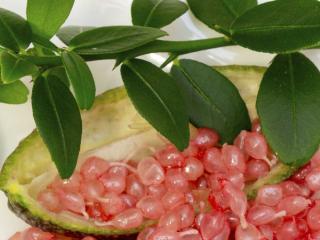 They need full sun to bear fruit.
They need full sun to bear fruit.In colder areas, plant your Australian finger lime in pots.
Finger lime isn’t a very hardy citrus.
Remove dead wood regularly and clear the inside branches of your Australian finger lime to let light penetrate to the center.
Do the heaviest pruning right after the harvest. Productive shoots should be pruned off every year, so the tree can replace them. Wear gloves: thorns are very prickly.
In summer, frequent watering is required, whereas watering can be reduced in winter. Picture below/right: rain doing its part!
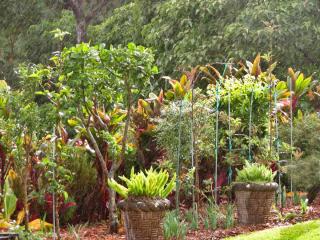 Water as soon as the soil is dry, without flooding the soil.
Water as soon as the soil is dry, without flooding the soil.Every two weeks, during the growth phase, add citrus-specific fertilizer to boost fruit-bearing.
It takes a couple years for flowers to appear, and then again two more seasons for fruits to set in earnest.
Along the way, you’ll have lots of questions about fruit set and fruit drop – Find the answers here: finger lime fruit set, drop and harvest.
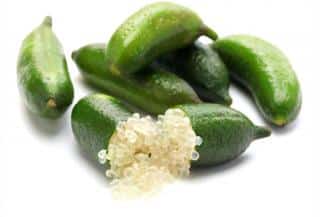
From wasabi-like green to ruby red to pearl white and purple, it’s a wonder this fruit is only mostly known in restricted circles!
Of all the citrus varieties, the finger lime family has the most colorful and varied fruits.
Australian finger lime trees are more or less vulnerable to the same diseases and parasites as all the other citrus plants.
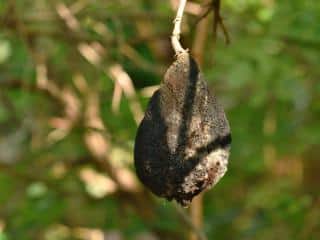
 Scale insects – cottony fuzz on leaves and fruits
Scale insects – cottony fuzz on leaves and fruitsThis tiny wasp only a few millimeters long lays eggs in fresh shoots. It commandeers plant growth to form a gall and then hatch. This pest is currently only in Australia, but sightings in New Zealand show it is spreading. The best way to deal with it is to prune out gall-infected branches before any adult citrus wasp hatches.
→ Did you know? Australian finger lime is the original host for citrus gall wasp. However, when planted with other non-native citrus, it will prefer laying on lemon, grapefruit, and mandarin citrus trees instead. Having been exposed to the parasite for longer, the native tree has developed a somewhat higher defense mechanism. Indeed, not all eggs and larvae on an Australian finger lime are able to reach maturity.
When ripe, each finger lime fruit contains hundreds of kernel-sized crystals under pressure under the skin. Upon slicing the fruit, these juicy beads burst out and are ready to nibble or eat directly!
Just like real caviar, each bead will wait until you bite it to release the juice inside. You can sprinkle a little sugar on it to reduce the tartness if need be.
It is perfect as a wonderful decoration to many dishes, topping for salads, or added on Tex Mex foods, too!
They’re also excellent paired with seafood, to replace the usual sliced lemon on oysters and seashells. Amateurs of sushi will love adding it as a delicious variation. Spread them across grilled fish to hydrate with a delicious touch. Also great with poultry and white meats.
You can pickle the entire fruit, especially for smaller varieties.
Cocktails with finger lime are also a real treat.
Finally, when blended or pressed, the juice works wonders in tarts, ice cream, and flans of all types.
The peel is also edible, like that of kumquat, though not as soft. Use it to replace lemon zests in many recipes for a new delicious experience.
Fruits will keep for up to a month if kept in the refrigerator.
It’s also possible to freeze them whole, but you won’t get the same texture as fresh ones. Incorporate them in Asian soups or noodles, jams, and other recipes where taste is more relevant.
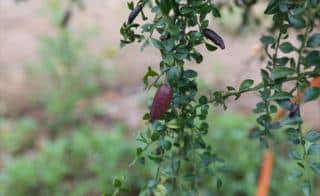
Their juice is trapped in tiny capsules that look like pearls, and burst in the mouth, releasing an explosion of flavors like lemon, citrus and grapefruit: this is the “lime caviar” that great chefs crave!
This special citrus evolved as a shrub in Australian rain forests (Queensland and New South Wales to be exact). Though part shade is the natural tropical habitat, in temperate climates full sun is needed or it won’t bear fruit well.
Thanks to cross-pollination and diverse growing conditions, a great many varieties exist. Most of them are still awaiting discovery. Wild finger lime trees are often genetically quite different from each other.
Pick the finger limes when they easily break off from their branch. Before that, they’re very bitter.
Hello, I have two finger lime trees. Both were doing well however have since both turned brown and dropped all leaves. I’m based in the Penrith area and we’ve had quite a bit of rain. So we loved the trees out of the wet and kept in an area where they receive full sun (no rain). We would only water once the soil was completely dry. Are the trees dead? Or is there still hope? We’re very new to finger limes and struggling to find some info.
Hi Mel, it would depend how the “turned brown” happened.
Case 1: Did the leaves curl up and dry out as they became brown? Ending up all crispy-crinkly? And doing so from the “older” leaves to the “more recent ones”? If so, then possibly they actually lacked water. A bit ironic, but that’s how we learn. It’s not that they don’t need water; they do, but it has to drain away quickly so that roots don’t wallow in it. Imagine that roots are like a paper straw: rain is fine, water is absorbed, but if it stays wet too long the straw falls apart. And if it doesn’t rain/get wet often enough, the plant dies, too, because it still has to drink.
Case 2: If the leaves turned brown but weren’t drying out, kind of staying flimsy but soft, then for some reason, despite your best efforts, they still did get some type of citrus root rot disease. I would only imagine that they were gravely infected before you lifted them out from the wet soil, and couldn’t recover.
Case 3: If the entire trees somehow turned dry and brown within very little time, I’m inclined to think that they died of transplant shock. This would happen if you:
– went from sun with lots of water to sun with nearly no water,
– and at the same time kept the trees whole (no pruning)
– and at the same time some of the roots got damaged/lost in the process (inevitable).
The only case where there’s hope is case 1, if you can cut the tree back to a large branch that still has green cambium underneath the bark. It will grow back from there.
I need to move my finger lime bush which is only young 1-2 years old. it is full summer in Western australia
I will transplant into well drained soil, full sun and minimum wind. and space around? but how much can I plant it next to a bay leaf tree near a fence? this is not an ideal time to do it I know! any tips Please?
it is currrently very happy with new growth appearing.
Hi Salli, well, it’s always possible to get things done even when the timing isn’t perfect… it just means more work! So if you can’t wait until fall (which would be better since the plant turns dormant), then just add the following steps to your transplanting:
– try to increase the size of the root ball you’re taking with the sapling. The larger, the better. For instance, if you can find a friend to help, you can heave a portion of the soil that’s 50 cm across (nearly 2 feet) and deep into a wheelbarrow.
– prepare the soil in the destination hole well, loosening it up and drenching it with water right before you place the tree clump in.
– water again abundantly after backfilling
– spread mulch around the tree but without piling it up around the trunk. A donut-like ring is better.
– important: for a couple weeks, try to hang a shade veil directly above the sapling. Horticulture stores sell this, you don’t need much, just about 1 square meter or yard. Hold it above with 4 stakes around the tree so that the midday sun doesn’t hit the finger lime directly.
– water in the evening, and again in the morning (not much, but having it twice a day helps the plant cope with transplant shock. You can even add sugar to the water to reduce risks of dying even more.
If you do all this, you’re sure to avoid transplant shock, which is your goal at this point.
As for the distance, it kind of depends how large you will want the tree grow in the long run. Australian finger lime can reach 6 meters (20 feet) high, but if you prune it you can keep it half that size. This means the ground beneath it must also be clear because you’ll want to stick ladders there to harvest the finger limes. So I’d recommend planting it at least 2 meters from the bay leaf. Note that bay is extremely vigorous, you’ll have to keep it under control every year or it’ll take over your fence (and the neighbor’s lot, too…)!
Hi,
I would like to know if these Australian Finger Lime commercial available?
Would love to taste it
Thanks
Hi Frieda, yes of course they can be purchased. I’ve seen them for sale in Europe, the United States, and different parts of Asia. I’m not so sure about South America and Africa. Check with your local nurseries, they’ll be able to tell you when and how to order some. Nature & Garden doesn’t sell plants, but sometimes on the garden forum you might find people willing to send or share seeds.
Thank you for this valuable information. I’m in the northeastern US. Last July I acquired a finger lime tree from a friend. I don’t know how old it is. It is in a pot and still indoors although the weather here is now warm enough to put it outside. I like having it easily accessible to keep an eye on it. It is under a grow light for about eight hours a day. I fed it citrus food November through February. I was delighted a couple weeks ago to see little white buds on the branches. Yesterday I followed your instructions for hand pollinating the open flowers.
My question is this: some leaves, mainly at the top closest to the light, have brown edges. I’ve been inspecting for pests and haven’t seen any. Should I worry?
Hi Mia! Nothing dramatic to worry about, browning leaf tips usually only means one of two things:
– not enough moisture in the air around the plant
– too much heat or direct sun.
They’re both related, in a way, because what happens is that heat and dry air make the leaves “transpire” or sweat faster than the roots can supply them with water, so they dry up where water runs out. You can try putting it in a place that gets slightly less sun, or veil it with a thin shade cloth during the hottest times of the day, or lastly simply increase air moisture around your potted citrus.
l just started to plant lemon caviar, one of my trees is like bushy he d’ont want to develop. what can do to encounter that ?
Hi Maurice, here are a few tips on pruning lemon caviar. It’s normal that it grows bushy, that’s how most citrus want to grow naturally. But you can prune it to shape it so that it has a few larger branches and then the fruiting branches at the end of them.
If only one tree stays small and doesn’t want to develop, maybe the soil under it isn’t rich enough, you can add fertilizer or compost or plant mulch.
hi , we have planted 2 finger lime trees 4 years ago, they do flower but do not produce any lemon. Any tips please ?
Hello Yves, at age 4 they should have started at least forming a few fruits.
Either they’re not pollinating well, in which case you can try hand-pollinating them, or the fruits are dropping while still very small. If that’s the case, you might want to check on adding a little citrus fertilizer. Most important is to ensure there’s enough water for the plant while fruits are forming. If too dry, it’ll drop them all to survive!
Hello Gaspard can you grow finger limes from seed?
Yes you can most definitely grow them from seeds. It’ll take up to 5 years to bear its first flowers, though.
You do not mention citrus gall wasp…the reason we are removing our lemon tree.
Does it affect finger lime and what can be done about it?
Hello Carol! Citrus gall wasp can and does affect Australian finger lime – it actually was the main host before newer strands of citrus were imported! But finger lime is more successful at blocking growth in the galls than other citrus varieties. This is certainly because it’s been dealing with the parasite for ages and is better at fighting it…
Sad to say the only major manner of preventing it is to prune off shoots that bear galls. This should be done on all trees within a circle 100 meters wide at least (100 yards). The pest doesn’t fly very far. Another way is to release some of its natural predators since there are two types of wasps that prey on its larvae. However, it’s a method more adapted to people with large orchards.